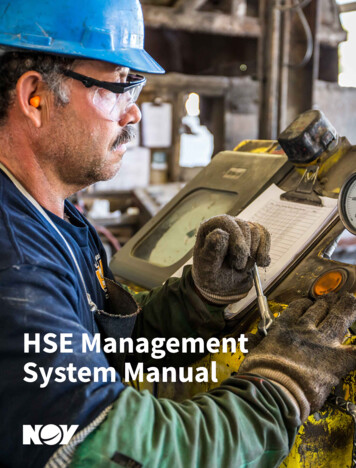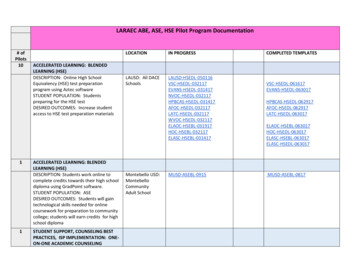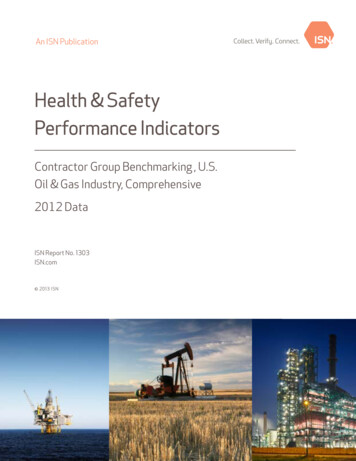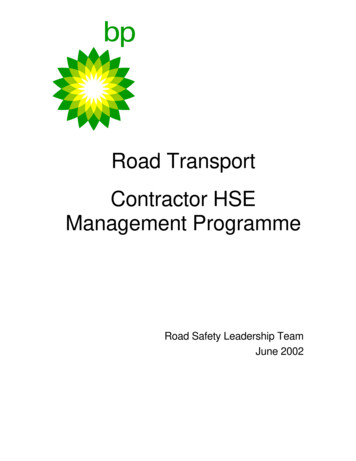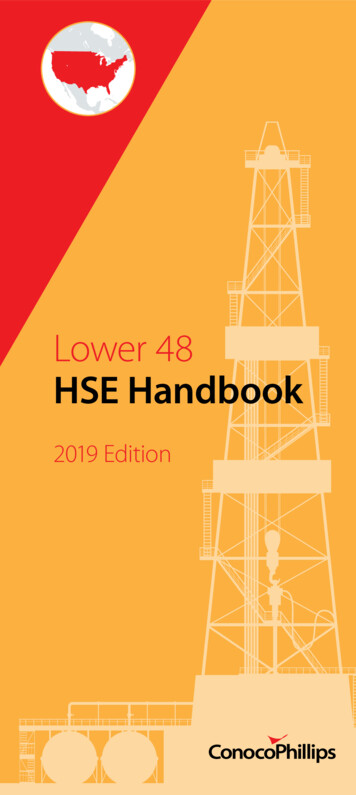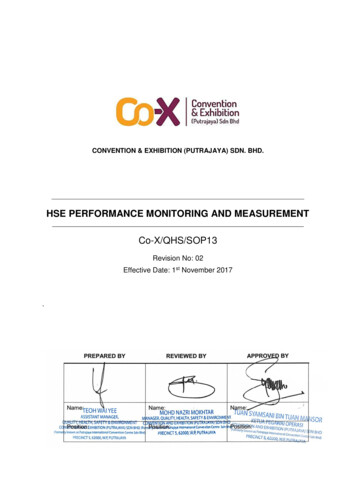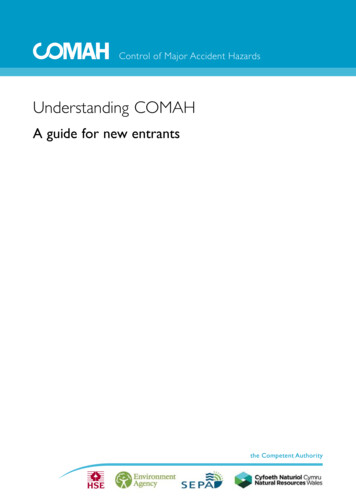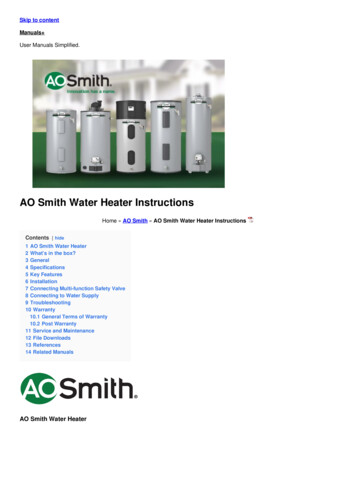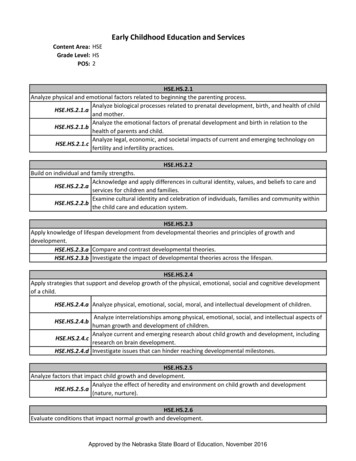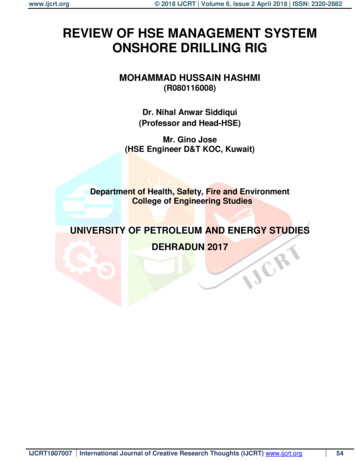
Transcription
www.ijcrt.org 2018 IJCRT Volume 6, Issue 2 April 2018 ISSN: 2320-2882REVIEW OF HSE MANAGEMENT SYSTEMONSHORE DRILLING RIGMOHAMMAD HUSSAIN HASHMI(R080116008)Dr. Nihal Anwar Siddiqui(Professor and Head-HSE)Mr. Gino Jose(HSE Engineer D&T KOC, Kuwait)Department of Health, Safety, Fire and EnvironmentCollege of Engineering StudiesUNIVERSITY OF PETROLEUM AND ENERGY STUDIESDEHRADUN 2017IJCRT1807007International Journal of Creative Research Thoughts (IJCRT) www.ijcrt.org54
www.ijcrt.org 2018 IJCRT Volume 6, Issue 2 April 2018 ISSN: 2320-2882ABSTRACTThe Drilling & Workover Operation in Oil & Gas industry considered theriskiest operation. The involvement of personnel and interaction with heavymachinery with no stop or rest. There are several types of Oil Well Drillingsystem named as Exploratory Wells, Development Wells and Workoveroperation. There are plenty of contracting companies around the world andout of them few are present in Kuwait.Fire, explosion, release of Hydrocarbon to open air are the high risk factor inthis industry. The Drilling operations involve high risk operationsdemanding more systematic approach to minimize the risk to Human life andEnvironment. The Drilling Contractors follows the international standardslike OHSAS, IOSH, HSE UK, API, etc. to develop the systematic approachto develop the incident free drilling operations. This project study reviewsthe “Health, Safety & Environment Management System” recommendationsand compliances to the Drilling Company.Keywords: Back ground of Drilling Operation, Drilling Equipment’s withCertification, Risk & Hazards Management, Audit/ Inspection, mplementationofHSEManagement System.IJCRT1807007International Journal of Creative Research Thoughts (IJCRT) www.ijcrt.org55
www.ijcrt.org 2018 IJCRT Volume 6, Issue 2 April 2018 ISSN: 2320-2882Introduction to KOC Drilling OperationCrude oil remains as one of the most important source of energy in the world. Despitethe latest emerging renewable energy, crude oil is still at the top due to its level ofsustainability, available production facilities and current technologies. Having said that,the burden lies on all companies committed to oil drilling in further expanding its scopeto attain maximum production along with the life span of a well. Among these burdensare efforts and means exerted in protecting the environment while exploring and drillingfor this so-called “black gold”.This project intends to give a simple orientation to readers with an interest in the oilindustry about the Health Safety Management in oil industry. The project, in its simplestform, journeys from source of hydrocarbons, to drilling, to the factors effecting theindustry and the mitigation measures. The project maps the web of industries involvedin the oil, its intricacies, how one is connected from another and its impact to oilproduction.The project also contains many photos to give the reader an impression of the typicalfacilities or equipment on a drilling rig. Online sourced photo sources are indicatedbelow the photograph.Hydrocarbon is an organic compound consists mostly of hydrogen and carbon. Eachcompound consists of hydrogen and Carbon atoms. As the name suggests these arelarge molecules made up of hydrogen atoms attached to a backbone of carbon. (Fig. 1.1)Hydrocarbons can be in the three states of matter: gases, liquids and solids.Hydrocarbons are very important because they are one of the Earth's most importantenergy resources. The predominant use of hydrocarbons is as a combustible fuel source.The role of hydrocarbons in human development cannot be underestimated. Essentiallywithout them, the modern age would not have manifested.IJCRT1807007International Journal of Creative Research Thoughts (IJCRT) www.ijcrt.org56
www.ijcrt.org 2018 IJCRT Volume 6, Issue 2 April 2018 ISSN: 2320-2882Fig 1.1 - HydrocarbonsSource: ere are many theories on the origin of hydrocarbons which can be classified into twocategories, organic theories and inorganic theories. The organic theory has beenaccepted more than the inorganic theory because it has more supporting evidence.The organic theories state that hydrocarbons are the result of the decomposition andtransformation of plants and marine animals under the impact of high temperature andhigh pressure conditions. The depth also plays as a factor as well.Oil is a fossil fuel that is formed from the remains of tiny plants and animals, known asplankton that died in ancient seas between 10 million and 600 million years ago (Fig 1.2).The plankton fell to the bottom of the sea and after decaying, the organisms formedsedimentary layers.In the layers, little or no oxygen is present and this allowsmicroorganisms to break down the remains into carbon-rich compounds that formorganic layer.The organic material is mixed with the sediments to form fine-grained shale, or sourcerock. As the sedimentary rocks layer, they exert extreme heat and pressure to distil theorganic material into crude oil and natural gas (Fig 1.3). The oil then flows from theIJCRT1807007International Journal of Creative Research Thoughts (IJCRT) www.ijcrt.org57
www.ijcrt.org 2018 IJCRT Volume 6, Issue 2 April 2018 ISSN: 2320-2882Source rock and accumulates in thicker, more porous limestone or sandstone known asreservoir rock.When the earth moves the oil and natural gas is trapped in reservoir rocks, which arebetween layers of impermeable rock, or cap rock. The whole process takes millions ofyears.Most oil and natural gas around the world is found in layers that were deposited duringthe Cenozoic era about 50 million years ago.Plant planktonen.wikipedia.org/wiki/Image:Ceratium hirundinella.jpgIJCRT1807007International Journal of Creative Research Thoughts (IJCRT) www.ijcrt.org58
www.ijcrt.org 2018 IJCRT Volume 6, Issue 2 April 2018 ISSN: 2320-2882Animal eb.com/eb/image?id 93510Fig 1.2 - PlanktonFig 1.3 - Organic Source Rock to OilIJCRT1807007International Journal of Creative Research Thoughts (IJCRT) www.ijcrt.org59
www.ijcrt.org 2018 IJCRT Volume 6, Issue 2 April 2018 ISSN: 2320-28821.2 Brief History of Kuwait Oil CompanyKuwait Oil Company was established in 1934 by the Anglo-Persian Oil Company, which isknown today as BP (British Petroleum), and Gulf Oil Corporation, now known asChevron.By 1938, oil was found in commercial quantities at Burgan Field. In June of 1946, HisHighness Sheikh Ahmad Al-Jaber Al-Sabah, the late Amir of Kuwait, inaugurated theexport of Kuwait’s first crude oil shipment.Shortly after, new fields were developed and export facilities were expanded, resultingin the construction of the North and South Piers, the Sea Island, and the Single PointMooring.In 1975, the Kuwait Government took 100% control over Kuwait Oil Company, and by1980, the Kuwait Petroleum Corporation was established to bring all state owned oilcompanies under one entity.IJCRT1807007International Journal of Creative Research Thoughts (IJCRT) www.ijcrt.org60
www.ijcrt.org 2018 IJCRT Volume 6, Issue 2 April 2018 ISSN: 2320-2882The Iraqi invasion of 1990 devastated KOC facilities. However, within months of Kuwait’sliberation in February of 1991, production gradually returned to full capacity.Super light crude oil was discovered at the Sabriya Field in 2005. The discovery of the API52 crude oil represented a great leap forward for the company’s exploration abilities.In 2006, gas was discovered in the deep Jurassic reservoirs at Rahiya, Mutriba, UmNigaand other fields throughout Kuwait. These discoveries fulfilled a long-standingKuwaiti dream of becoming self-sufficient in gas that can be used for power generation.In 2011, KOC successfully achieved its goal of reducing gas flaring to approximately 1%.Compared to gas flaring levels of as high as 17% just a few years earlier, this represented amajor accomplishment for KOC.Today, KOC continues to live up to its stated mission of exploring, developing andproducing Kuwait’s hydrocarbon resources for its customers around the world in a waythat is environmentally sound and economically viable.IJCRT1807007International Journal of Creative Research Thoughts (IJCRT) www.ijcrt.org61
www.ijcrt.org 2018 IJCRT Volume 6, Issue 2 April 2018 ISSN: 2320-28821.3 Drilling Rig TypesTo take the hydrocarbon entrapments from the crust, there are many different type ofdrilling rigs such as Land Rigs, Drill Ship, Semisubmersibles, Jack ups, and many more (fig1.4). They are different based on where the reservoir is located, the depth of thereservoir, power needed and other factors.IJCRT1807007International Journal of Creative Research Thoughts (IJCRT) www.ijcrt.org62
www.ijcrt.org 2018 IJCRT Volume 6, Issue 2 April 2018 ISSN: 2320-2882Figure 1.4 Types of Drilling RigsThere are three different rigs used based on Horse Power:1- Work over RigsWork over Rigs used to any kind of oil well intervention involving invasive techniques,such as wire line, coiled tubing, snubbing, expensive process of pulling and replacing acompletion. Work over Rig’s Engine is smaller than the Drilling Rig Engine. Work over rigHP varies from 350 to 950 HP, but some Work over Rigs needs high HP for deep wells.2- Development Drilling RigsDrilling rig used to drill a well in a known field, so there are plenty of drilling records andexperience from drilling many wells in the same field in the past.The main objective is to drill a well to further develop the field by increasing therecovery and production. These are called “Development Wells”.The engine HP varies from 1000 HP to 3000 HP depending on the Rig capacity and theload that can be handling.3- Exploration OperationDrilling a well in a new area with no previous drilling experience and record for the areato be drilled .Exploration operations usually proposes drilling such a well to find newIJCRT1807007International Journal of Creative Research Thoughts (IJCRT) www.ijcrt.org63
www.ijcrt.org 2018 IJCRT Volume 6, Issue 2 April 2018 ISSN: 2320-2882reserve that requires Deep drilling (10,000 to 28,000 ft) which uses Super Rigs (High HP).The Super Rigs have engine that can generate more than 3000 HP.There are many factors that impact the selection of the proper Horse power to use onthe Drilling Rig such as:1- Depth of the Well for Drilling & Work Over.2- Maximum Weight of string and BHA (Bottom Hole Assembly).3- Maximum Pump Capacity.4- Maximum Hoisting Load.5- Over pull jobs (like Jarring, Fishing, stuck & others).6- Mud System.Mud PumpsIJCRT1807007International Journal of Creative Research Thoughts (IJCRT) www.ijcrt.org64
www.ijcrt.org 2018 IJCRT Volume 6, Issue 2 April 2018 ISSN: 2320-28821.4 Types of drilling well geometriesWells can be drilled in a number of different geometries from the simplest vertical wellto complicated multilateral completions.There are many different types of well but the most common one are as vertical,deviated, and horizontal well. (Fig. 1.5)The selection of drilling type is based on the reservoir conditions and economic analysis.Figure 1.5 Vertical & Horizontal DrillingSource: http://www.intragaz.com/en/geophysics drilling.htmlVertical Wells:Vertical well are the most common wells and conventional. They are selected for thick,permeable formation. (fig 1.6)Vertical wells are used with vertical hydraulic fractures for thick, low permeabilityformations.IJCRT1807007International Journal of Creative Research Thoughts (IJCRT) www.ijcrt.org65
www.ijcrt.org 2018 IJCRT Volume 6, Issue 2 April 2018 ISSN: 2320-2882Figure 1.6 Vertical wellDirectional Wells or Deviated Wells:Deviated wells drilling non-vertical hole which purposely deviated from the vertical,using controlled angles to reach an objective location other than directly below thesurface location. A directional well may be the original hole or a directional "sidetrack"hole that deviates from the original bore at some point below the surface. (fig 1.7)Figure 1.7 Deviated WellIJCRT1807007International Journal of Creative Research Thoughts (IJCRT) www.ijcrt.org66
www.ijcrt.org 2018 IJCRT Volume 6, Issue 2 April 2018 ISSN: 2320-2882The Objective of directional drilling: Drill multiple wells from the same location. To intersect multiple targets (reservoir) from the same well. To reach targets below an inaccessible areas for drilling. Directional drilling can be utilized to perform sidetrack a fish and avoid drilling introuble some formation such as salt dome and fault lines. To save cost and time.Reasons of Directional Drilling1. Drilling multiple wells from offshore structures with the same rig.Figure 1.8 Multi Well Drilling2. Directional drilling technology allows the industry to access deposits underneathobstacles or buildings. Without the directional drilling it maybe otherwise considered asinaccessible.IJCRT1807007International Journal of Creative Research Thoughts (IJCRT) www.ijcrt.org67
www.ijcrt.org 2018 IJCRT Volume 6, Issue 2 April 2018 ISSN: 2320-2882Figure 1.9 Inaccessible Locations3. SidetrackingFigure 1.10 Side Tracking4. Controlling Vertical DrillingFigure 1.11 Controlling Vertical DrillingIJCRT1807007International Journal of Creative Research Thoughts (IJCRT) www.ijcrt.org68
www.ijcrt.org 2018 IJCRT Volume 6, Issue 2 April 2018 ISSN: 2320-28825. Directional drilling can be as a relief well.Figure 1.12 Relief well6. Shoreline DrillingFigure 1.13 Shoreline Drilling7. Fault DrillingFigure 1.14 Fault DrillingIJCRT1807007International Journal of Creative Research Thoughts (IJCRT) www.ijcrt.org69
www.ijcrt.org 2018 IJCRT Volume 6, Issue 2 April 2018 ISSN: 2320-28828. Salt Dome DrillingFigure 1.15 Salt Dome DrillingHorizontal Wells:Horizontal wells are used for thin, permeable formations. Thin oil columns over laid bygas and/or under laid by water.Horizontal wells are also used for naturally fractured reservoirs.The Objective of Horizontal drilling: To increase production. To reduce water conning problem. To reduce sand production problem. To intersect vertical natural fractures that are filled with oil and located in a lowpermeability reservoir.Multi- Lateral Wells:Multi-Lateral well is a well that has one vertical section and several lateral (horizontal)sections.Multilaterals drilling is used for layered reservoirs to maximize oil/gas production.Multi-Lateral wells combine the benefits of the directional and horizontal wells.IJCRT1807007International Journal of Creative Research Thoughts (IJCRT) www.ijcrt.org70
www.ijcrt.org 2018 IJCRT Volume 6, Issue 2 April 2018 ISSN: 2320-2882Figure 1.16 Multi-Lateral WellIJCRT1807007International Journal of Creative Research Thoughts (IJCRT) www.ijcrt.org71
www.ijcrt.org 2018 IJCRT Volume 6, Issue 2 April 2018 ISSN: 2320-28821.5 Introduction to Drilling ContractorOperating CompanyAn operating company primary business is working with oil and gas. The OperatingCompany, for example Kuwait Oil Company (KOC) obtains the right to drill oil wells toproduce oil at a particular site or area from the ministry.Drilling CompanyMost operating companies find it more cost effective to hire expertise and equipmentfrom drilling companies / contractors.Drilling Companies responsible on drillingactivities based on operating company objectives and programs.Operating company and drilling contractor sign an agreement called Drilling contractwhich describes the drilling project, determines the cost of each operation and statestype of services.Service CompanyService companies provide the required tools and services necessary to complete thedrilling of the well. These services include sales of chemicals, mud, cement, logging,wire-line, running casing and installing wellheads, etc.Rig PersonnelDrilling a well requires hiring many skilful employees to run the rig and operate thedrilling operations. Each one of them is very important and has to have a full awarenesson the drilling operations to ensure safety. There are usually two shifts, each work for 12hours shift. Each shift consists of a driller, assistant driller, Derrick man, and Floor hands.The tool pusher oversees the drilling crew and ensures to keep the drilling operationsgoing according to the drilling program.IJCRT1807007International Journal of Creative Research Thoughts (IJCRT) www.ijcrt.org72
www.ijcrt.org 2018 IJCRT Volume 6, Issue 2 April 2018 ISSN: 2320-2882Rig Superintendent - Tool pusherTool pusher works for the drilling contractor. Tool pusher supervises the drilling crewand coordinates between the drilling contractor and the operating company. He isresponsible on the drilling operations and the drilling crew.Night Tool pusherNight tool pusher relieves the Tool pusher during night time.DrillerDriller operates drilling equipment to drill hole of the well and supervise the drilling crewsuch as the assistant driller, derrick man, and floor hands (also called rotary helpers orroughnecks). The driller operates from the driller’s console to maintain proper bitweight, pump rate, pump pressure and RPM. Driller works in shifts which is usually 12hours shift.Assistant Driller (A/D)Assistant Driller assists the driller in the drilling operations and helps him out to monitorthe drilling operations parameters and supervise the rest of the drilling crew on the rigfloor.Derrick manDerrick man responsible on handling the upper part of the pipe from the derrick’sMonkey board while tripping. He maintains mud and solids control equipment whiledrilling. He also maintains the crown block.Derrick man has to wear a fall protection equipment to prevent him from falling andkeep him safe.Floor handsFloor hands usually consist of two to three floor hands depending on the size of the rig,the rig operations and many other factors. Floor hand work on the rig floor near therotary table and they work in rough working tasks such as handling drill pipesconnections or drill pipes disconnections, using large wrenches called tongs to screw andunscrew the pipe.IJCRT1807007International Journal of Creative Research Thoughts (IJCRT) www.ijcrt.org73
www.ijcrt.org 2018 IJCRT Volume 6, Issue 2 April 2018 ISSN: 2320-2882Floor hands also maintain the rig equipment, repairing the rig equipment, cleaning therig floor and the equipment, and painting.Floor hands are also called rotary helpers, or roughnecks.Additional Personnel:ElectricianHe is responsible on the rig electricity devices and maintains the condition of thesedevices to run smoothly without any major shutdowns.MechanicHe is responsible on the rig engines devices and maintains the condition of these devicesto run smoothly without any major shutdowns.Drilling Fluids Engineer / Mud EngineerHe is responsible on the mud properties and mud analysis during the drilling operationto help out the drilling operations and adding chemical additives based on the wellconditions.The mud is very similar to the human blood in a way. It is very important for the systemand brings energy and it cleans the system.For that reason the Drilling Fluid Engineer is called the Mud Doctor, he diagnose what iswrong with the mud and the system overall and ensures that the drilling operationremains fit and healthy, which is same as the normal doctor checks the blood foranything abnormal. He checks for any genetic defects (downhole problems) and theblood disorders (contaminants).He must be knowledgeable of the total system (formation and well), so he canprescribes the appropriate remedial treatments to ensure the correct problems andmaintain a chemical balance to maximize performance.Safety officerHe is responsible for the safety on the rig and supervises the rig operations. He mitigatesthe hazards on the rig and work to eliminate or minimize the impact of these hazards.MedicMedic do minor medical checks and first aid to the rig crew.IJCRT1807007International Journal of Creative Research Thoughts (IJCRT) www.ijcrt.org74
www.ijcrt.org 2018 IJCRT Volume 6, Issue 2 April 2018 ISSN: 2320-2882Forklift OperatorHe operates the forklift and other similar type of machinery to help out with theoperations.CompanyManService Co.Mud Eng.CementerMud LoggerTool PusherOtherDrillerRotaryRoughHelpersNeckCrane icianMud LoggersRoustaboutfig 1.17 Rig Personnel ChartFig 1.18 Rig CrewSource: er/IJCRT1807007International Journal of Creative Research Thoughts (IJCRT) www.ijcrt.org75
www.ijcrt.org 2018 IJCRT Volume 6, Issue 2 April 2018 ISSN: 2320-28821.6 Drilling Operational ProblemsThere are many problems that might occur while drilling such as: Lost circulationLost circulation happens when there is uncontrolled flow of drilling fluids comes intodown hole formation. This can be either a partial loss, some returns to the surface or acomplete loss with no returns to the surface. This happens when the drilling encountersa highly fracture zone, one with low pressure-high permeability or a cave-in and weakformations. If drilling is continued with no returns it is called dry or blind drilling.Lost circulation problem could lead to high costs and could be an expensive problem indrilling.Lost circulation problem could happen at any depth regardless of the mud type or themud weight which being used.Poor cement job is the most common cause for lost circulation.The best solution to this problem is to:1. Maintain proper mud weight2. Minimize annular friction pressure3. Maintain adequate hole cleaning4. Set casing to protect weaker formations5. Treat mud with loss circulation materials if anticipated.When loss circulation happens, then the best thing to do is:1. Pump loss circulation materials in the mud2. Seal the zone with cement or other blockers3. Set casing4. Dry drill (clear water)IJCRT1807007International Journal of Creative Research Thoughts (IJCRT) www.ijcrt.org76
www.ijcrt.org 2018 IJCRT Volume 6, Issue 2 April 2018 ISSN: 2320-2882 Drill Pipe FailuresThere are common drill pipe failures such as:o Twist offo Partingo Burst or collapseo Fatigueo LeakingMost of these are prevented by starting with a good string. Drill pipe and collars shouldbe constantly inspected, and regularly tested. Differential and Mechanical sticking of drilling stringPipe Sticking happens when you experience the inability to move the pipe or rotate.There are two types of sticking differential and mechanical sticking.Differential Sticking:There are several factors that might causes of differential sticking such as:1. High differential pressures (over balance)2. Thick mud cake (continuous high fluid loss to formation)3. Low-lubricity mud cake (high coefficient of friction)4. Pipe left stationary for some time (delay in operations).Several signs indicate the pipe differential sticking such as:1. Increase in torque and drag.2. Inability to move the pipe.3. Circulation of drill fluid is interrupted.There are ways to minimize differential sticking such as:1. Using proper mud characteristics (weight, fluid loss)2. Using collar shape (spiral or square collars)3. Keep drilling solids low in the mud4. Keep rotating the drill stringIJCRT1807007International Journal of Creative Research Thoughts (IJCRT) www.ijcrt.org77
www.ijcrt.org 2018 IJCRT Volume 6, Issue 2 April 2018 ISSN: 2320-2882Mechanical Sticking:Mechanical Sticking happens when you high accumulation of cuttings accumulate in theannulus. Usually it happens in wells that do not have efficient well hole cleaning. Thisproblem is common in directional or horizontal wells.Increase in circulating pressure while drilling, or increase in drag when tripping is a goodindication of the problem. It is a good idea to circulate bottoms up before tripping thepipe as this cleans the hole.There are ways to minimizing mechanical sticking such as:1. Using efficient drilling hydraulics, rate and viscosity2. Using high rotation rate in directional holes Hole DeviationThe bit tends to walk while drilling when the hole deviates from the vertical or plannedcourse. The formation dip and rock properties can influence the path of the bit.This can be a result of:1. Using improper drill string that suits the formation2. Having insufficient Weight on bit.3. Rock characteristics and rock nature which can lead to deviation in the hole.4. Using improper RPM of the drill string.The hole deviation problem can be corrected by changing the BHA or by adding morestabilizers. Lowering the Weight on bit & slowing the rotation can also happen tominimize the problem.Hole deviation also known as Dog leg problem.IJCRT1807007International Journal of Creative Research Thoughts (IJCRT) www.ijcrt.org78
www.ijcrt.org 2018 IJCRT Volume 6, Issue 2 April 2018 ISSN: 2320-2882 Borehole InstabilityBorehole Instability problems are common in shale sections of the hole. Shale canplastically flow inward or slough causing mechanical sticking.Salt also exhibits plastic behaviors. Any weak formation can collapse if the mud weighthigher that the formation pressure. Indications of trouble are an increase in the torque,increase in circulating pressure or even the blocking of returns to the surface.Borehole Instability problems can be caused by erosion due to drilling fluid and thenature of the corrosive materials. Also, it can be caused by chemical reaction betweenthe formation and the fluids. Or even from the mechanical stresses while drilling.To prevent the borehole instability starts with having a good mud design, maintain andcontrol the mud weight and water loss CorrosionThe corrosion happens when destruction of metal by chemical or electrochemicalinteraction with the environment. The drill pipe gets affected by the corrosion and asresult of this the pipe gets weaker and weaker till the pipe failure and cause washouts.Carbon dioxide (CO2) and Hydrogen sulfide (H2S) and dissolved oxygen (O2) are themain corrosive materials.There are influencing factors such as temperature, fluid chemical composition, velocity,pressure.There are ways to minimize the impact of corrosion by close monitoring andmaintenance.IJCRT1807007International Journal of Creative Research Thoughts (IJCRT) www.ijcrt.org79
www.ijcrt.org 2018 IJCRT Volume 6, Issue 2 April 2018 ISSN: 2320-2882 Bit BallingBit balling happens when shale formation forms soft and sticky clay when exposed towater. Sticky clay can adhere to water wet metal. This problem can become seriouswhen the clay starts to block the annulus or cover the bit completely.There are ways to prevent the bit balling by maintain good bit and hole cleaning. Torque and DragTorque is rotational resistance arising from contact with the wellbore. Drag is the linearresistance. Excessive wall contact and sticky clays can increase the torque and drag. Thedrilling efficiency reduced when we have the torque and drag problem.Additives such as lubricants can be added to minimize the effect of the torque and dragproblem. Key SeatThe key seat is formed when drill string is not aligned right or the hole is not straight.That drill string start to press against the side of the hole and as a result of that a cuttinggroove gets formed, so when pulling out of the hole the BHA will catch on the groove.That is why it is always recommended to keep the hole in proper alignment. H2SH2S is Hydrogen sulfide. It is a poisonous gas. Hydrogen sulfide is a serious hazard. H2Shas the odor of rotten eggs at low concentrations but it is odorless at highconcentrations.IJCRT1807007International Journal of Creative Research Thoughts (IJCRT) www.ijcrt.org80
www.ijcrt.org 2018 IJCRT Volume 6, Issue 2 April 2018 ISSN: 2320-2882Even in low concentrations; H2S is hazardous to workers and sometimes can be lethal.The effect of H2S depends on duration, frequency and intensity of exposure as well asthe susceptibility of the individual.H2S stress cracking is a hydrogen embrittlement phenomenon, where the equipment incontact with H2S containing liquid undergo atomic reactions and cracks develop.For this reason it is essential to control the hazard of Hydrogen sulfide by the following:1. Crew adequate training & conduct H2S drills.2. Conduct Pre-job meetings.3. Install H2S Detection devices.4. Using Respiratory Equipment.5. Implement safe work procedures.6. Implement emergency response procedures.7. Monitor H2S concentration in the rig.8. Good maintenance of H2S devices & NACE certifications.9. Planning ahead. FishingIf a tool is lost or the drill string breaks, the obstruction in the well is called junk or fish. Itcannot be drilled through. Special grabbing tools are used to retrieve the junk in aprocess called fishing. In extreme cases, explosives can be used to blow up the junk andthen the pieces can be retrieved with a magnet Well controlWell control is very critical to the safety of the whole drilling operation and the crew.Well control can be an issue when having a kick. A kick is an entry of formation fluid suchas water, gas and oil or other formation fluid into the borehole. If the well leftIJCRT1807007International Journal of Creative Research Thoughts (IJCRT) www.ijcrt.org81
www.ijcrt.org 2018 IJCRT Volume 6, Issue 2 April 2018 ISSN: 2320-2882uncontrolled a kick can develop into a blowout (uncontrolled release of crude oil and/ornatural gas from an oil well or gas well after pressure control systems have failed).Well control procedures might vary from one rig to another and from one company toanother.There are several safety measures to control the well such as:1. Rig controlBOP's, FOSV, Mud pumps, Draw works and other rig equipment. Thedrillerisresponsible on rig control equipment.Blow Out Preventer (BOP)2. Mud ControlMud engineer and the Derrick man operate the mixing system and chemical addition tohave a good mud mixture that suits the dril
reserve that requires Deep drilling (10,000 to 28,000 ft) which uses Super Rigs (High HP). The Super Rigs have engine that can generate more than 3000 HP. There are many factors that impact the selection of the proper Horse power to use on the Drilling Rig such as: 1- Depth of the Well for Drilling & Work Over.
